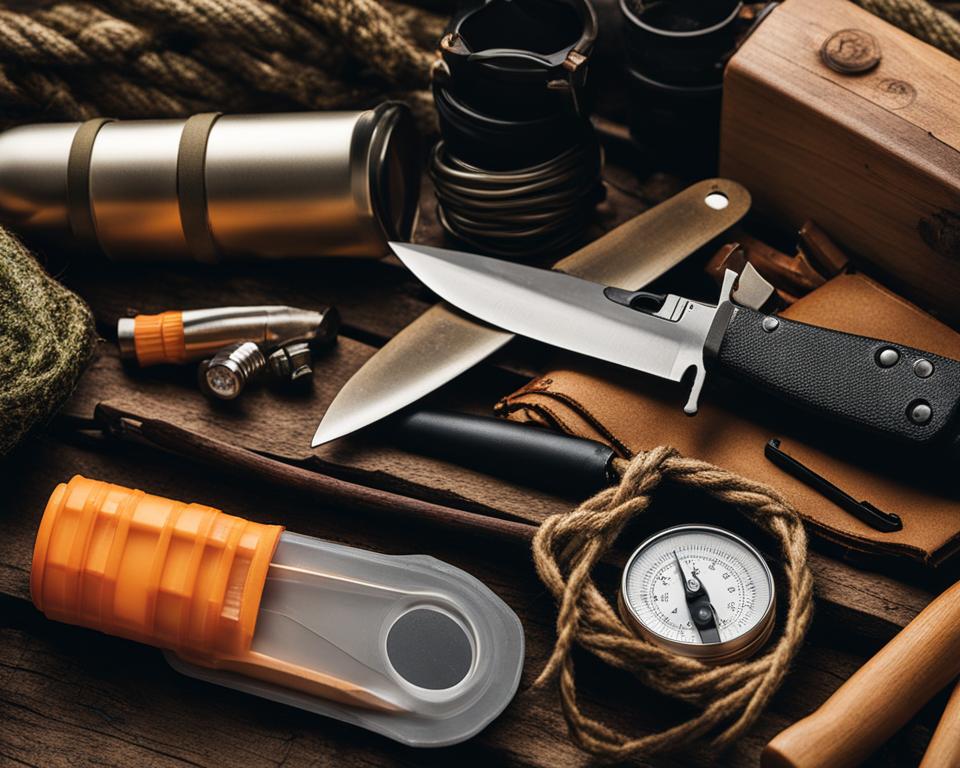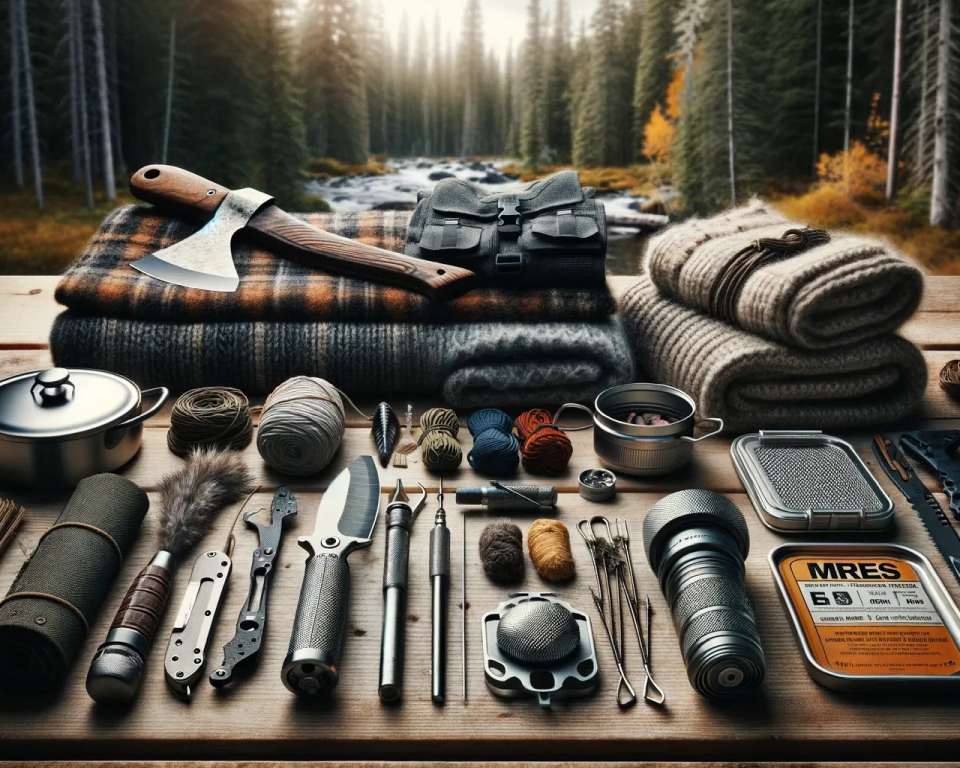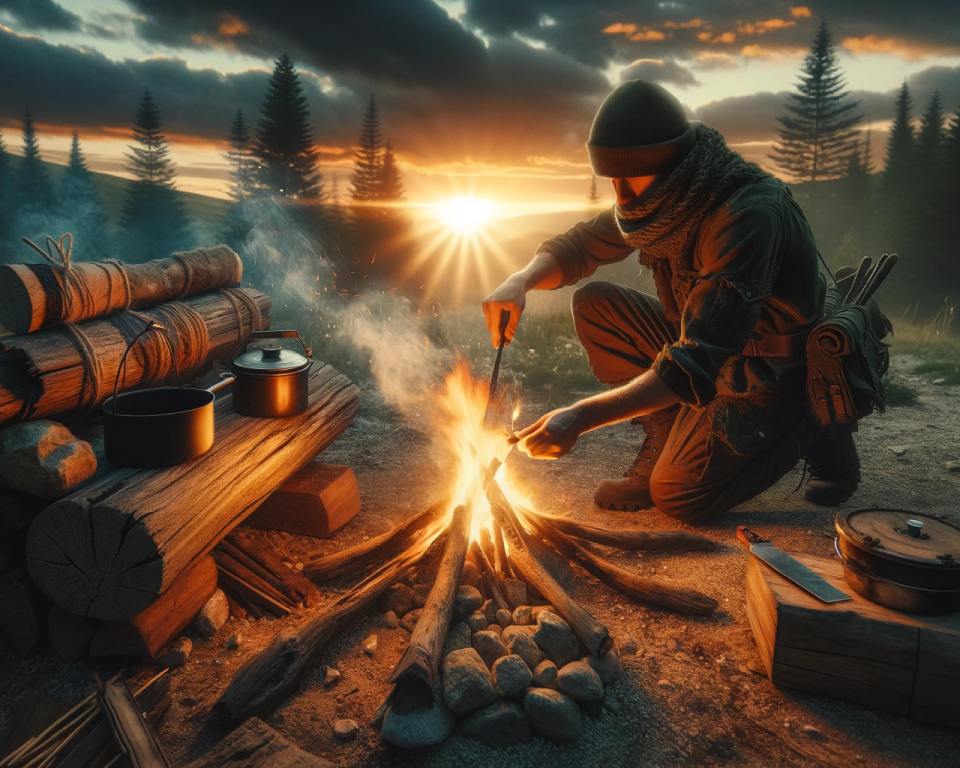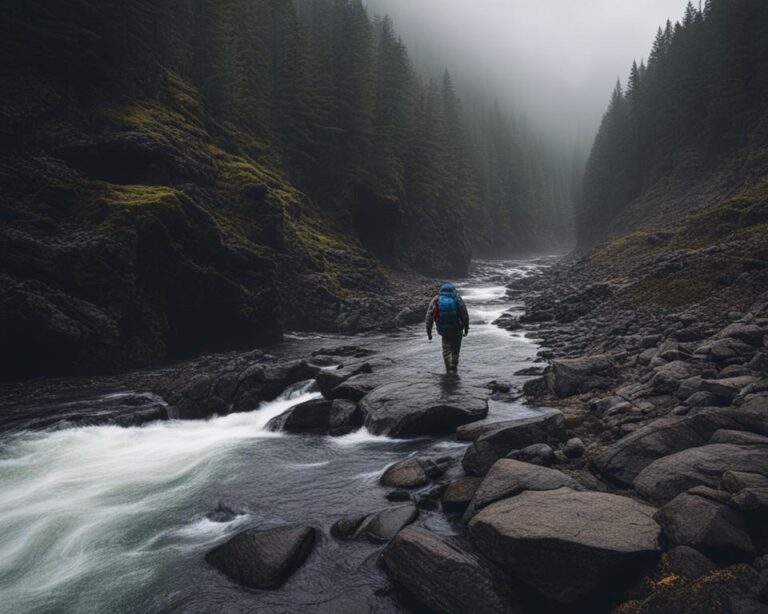Essential Wilderness Survival Gear and Skills
When it comes to wilderness survival, having the right gear and skills is crucial. Whether you’re an experienced outdoor enthusiast or a novice adventurer, being prepared for any situation can mean the difference between life and death. In this article, we will explore the essential wilderness survival gear and skills that are necessary to navigate and thrive in the great outdoors.
From survival techniques and outdoor survival tips to bushcraft skills and emergency preparedness, there is a wide range of knowledge and gear that can help us overcome challenges and stay safe in the wilderness. We will delve into everything from the basics of building a survival gear list to understanding the importance of navigation, shelter, clothing, and fire starting methods.
Whether you are planning a short hike or an extended expedition, being equipped with the right wilderness survival gear and skills is paramount. Join us as we explore the essentials of primitive survival skills, wilderness survival gear, and wilderness survival training. Let’s embark on a journey to become confident and adept stewards of the natural world.
In the following sections, we will discuss the gear and skills required for short-length wilderness survival, additional gear for extended survival situations, the importance of transportation and load carrying, navigating the wilderness, building shelter, choosing the right clothing, starting a fire, and cooking in the wild. Let’s dive in and discover the tools and knowledge necessary for a successful wilderness adventure.
Creating a Survival Gear List
When it comes to preparing for wilderness survival, having the right gear is essential. But with so many options available, it can be overwhelming to decide what to include in your pack. To help you navigate this process, we’ve put together a comprehensive guide to creating a survival gear list that will keep you prepared for any situation.
When compiling your gear list, it’s important to strike a balance between modern gear and more primitive tools. Modern gear, such as high-quality tents, lightweight sleeping bags, and GPS devices, can enhance your comfort and safety in the wilderness. On the other hand, primitive gear, like flint and steel fire starters, handmade shelters, and natural navigation methods, can provide valuable skills and a deeper connection to nature.
Before including any item on your gear list, take the time to familiarize yourself with it and ensure you are confident in using it. There’s no point in carrying gear that you don’t know how to use effectively. Practice with each tool or piece of equipment, so you can rely on them when you need them the most.
When it comes to survival gear, redundancy is key. It’s always wise to have backups for critical items like fire starters, navigation tools, and lighting sources. Additionally, consider using gear containers or dry bags to protect your equipment from water damage and ensure everything stays organized.
The type and amount of gear you need will vary depending on the duration of your trip and the specific needs of your situation. A day hike requires a lighter load compared to a multi-day backpacking expedition. Consider factors such as the terrain, weather conditions, and remoteness of your destination when assembling your gear list.
“Having a well-thought-out gear list is crucial when venturing into the wilderness. It’s the foundation of your survival toolkit, providing you with the tools and resources to overcome challenges and ensure your safety.”
Essential Gear for Wilderness Survival:
- Reliable shelter (tent, tarp, or hammock)
- Sleeping bag suitable for the expected temperature
- Fire starters (lighters, matches, ferrocerium rods)
- Navigational tools (compass, map, GPS device)
- First aid kit
- Water purification methods (water filter, purification tablets)
- Extra clothing appropriate for the weather conditions
- Food and cooking supplies (compact stove, utensils, freeze-dried meals)
- Headlamp or flashlight with extra batteries
- Multi-tool or pocket knife
- Emergency signaling devices (whistle, signal mirror)
- Personal hygiene items (toilet paper, hand sanitizer)
- Emergency shelter (emergency blanket, bivvy sack)
- Paracord or rope
Remember, this gear list serves as a starting point. Customize it according to your own preferences and the specific challenges you may face in the wilderness. By creating a comprehensive survival gear list, you’ll be well-prepared to tackle any adventure with confidence.
Essential Gear for Short-Length Wilderness Survival
When venturing into the wilderness, it’s crucial to be equipped with the right gear for your safety and survival. In short-length wilderness survival situations, the following essential items are vital for your preparedness:
- Fire Starting Methods: Lighters, matches, and a flint and steel with a magnesium strip are reliable options for starting a fire in various conditions.
- Tinder Bundle: A large, dry tinder bundle will help ignite your fire quickly and efficiently.
- Flashlight/Headlamp: A handheld flashlight or headlamp, along with extra batteries, is essential for visibility during low-light situations.
- Fixed-Blade Knife: A sturdy fixed-blade knife is versatile and indispensable for various survival tasks such as cutting, preparing food, and self-defense.
- Compass and Map: A reliable compass and a detailed map of the location are crucial for navigation and orienteering.
- Emergency Whistle: An emergency whistle is a valuable tool for signaling for help and alerting others to your location.
- Poly-Cord Rope: Strong and durable poly-cord rope is essential for building shelter, securing equipment, and creating emergency structures.
- Ziploc Bags: A variety of sizes of Ziploc bags are useful for organizing, protecting, and waterproofing smaller items.
- First Aid Kit: A well-stocked first aid kit is essential for treating injuries and providing medical assistance in emergency situations.
- Rain Poncho: A large rain poncho will keep you dry during wet weather and can also be used for improvising shelter.
- Emergency Blanket: An emergency blanket provides essential insulation, helping to retain body heat and ward off hypothermia.
- Stainless Steel Cup/Canteen: A stainless steel cup or canteen enables you to boil and purify water, ensuring a safe and reliable source of hydration.
- Water Purification Methods: Include water purification tablets, a water filter, or a portable water purification system to ensure access to clean drinking water.
- Extra Warm Clothing: Pack extra layers of warm clothing, including thermal base layers, thick socks, and insulated outerwear to protect against low temperatures.
Incorporating these essential items in your wilderness survival gear ensures that you are well-prepared for short-length expeditions, increasing your chances of staying safe and comfortable in challenging situations.
Additional Gear for Extended Wilderness Survival
When it comes to more extended wilderness survival situations, having the right additional gear can make a significant difference. Here are some essential items to consider including in your survival kit:
- Hatchet/Kukri Knife: A sturdy hatchet or a quality large kukri knife is invaluable for chopping and splitting wood, helping you build a shelter and create fire.
- Wool Blanket: A wool blanket is an excellent addition to your gear as it provides insulation even when wet, keeping you warm in cold and damp conditions.
- Fishing Line and Lures: Pack some fishing line and lures to catch food from nearby water sources. This can provide an additional source of sustenance.
- Wool Clothing: Adding wool clothing to your survival gear is a smart move as wool retains warmth, even when wet. It helps regulate body temperature and provides insulation.
- Stainless Steel Cooking Pot: A small stainless steel cooking pot is essential for boiling water, cooking food, and melting snow for drinking water.
- Multi-Tool: A versatile multi-tool is invaluable for various tasks such as cutting, opening cans, and repairing gear. Choose a reliable and high-quality option.
- MREs/Dried Food: Include MREs (Meals Ready to Eat) or dried food in your survival kit. These ready-to-eat options provide sustenance when fresh food is scarce.
- Bow and Drill Friction Fire Set: As a backup fire-starting method, a bow and drill friction fire set can help you start a fire in any location, even when other tools fail.
Having these additional items in your wilderness survival kit increases your chances of staying safe, comfortable, and well-prepared during extended expeditions. Remember, proper equipment and preparedness are key to surviving in the wild.
Importance of Transportation and Load Carrying
When it comes to wilderness survival, transportation and load carrying methods are vital considerations. Depending on your specific situation, various options such as an expedition canoe, pack raft, pack animal, or backpack may be beneficial for transporting your equipment. The chosen method should be able to handle the weight of your gear and have the necessary load carrying capacity.
For those seeking a water-based transport option, an expedition canoe or pack raft can be excellent choices. They offer the advantage of navigating rivers and lakes, allowing you to cover long distances efficiently. These vessels provide enough space to carry a significant amount of gear, making them suitable for extended expeditions.
Using an expedition canoe or pack raft allows us to access otherwise inaccessible areas and transport heavy loads, ensuring we can carry the necessary supplies for wilderness survival.
If a water-based option is not suitable, a pack animal can be an excellent alternative. Whether it’s a horse, llama, or even a mule, pack animals can carry heavy loads and traverse challenging terrains. They are especially valuable for longer trips where you may need additional supplies or equipment.
If you prefer a more conventional approach or have a shorter expedition, a backpack might be the appropriate choice. When selecting a backpack, ensure it is durable and has sufficient load carrying capacity to accommodate your gear. It should also provide sufficient comfort and support while distributing the weight evenly to prevent strain and fatigue.
Remember to pack strategically, considering the weight and dimensions of each item. Prioritize essential equipment and evaluate whether certain items can serve multiple purposes. This will help optimize the load carrying capacity and reduce unnecessary weight.
Ultimately, the choice of transportation and load carrying method will depend on your specific needs, duration of the trip, and the terrain you will encounter. Consider the practicality, efficiency, and load carrying capacity of each option to ensure a successful wilderness survival experience.
 Navigating the Wilderness
Navigating the Wilderness
Navigating the wilderness is crucial for survival. Whether you’re exploring remote areas or facing an unexpected situation, having the right navigation skills and tools can make all the difference. In this section, we will discuss the key elements of wilderness navigation, including compasses, topographic maps, orienteering, GPS devices, and the importance of honing your navigation skills.
When venturing into the wilderness, it is essential to have a reliable compass and a topographic map of the area. A compass helps you determine your direction and navigate through unfamiliar terrain. Paired with a topographic map, which shows the detailed features of the land, you can plan your route, identify landmarks, and stay on track.
Learning basic orienteering skills is recommended to enhance your navigation abilities. Orienteering involves using a map and compass to navigate from point to point, finding the most efficient route through the wilderness. It helps you interpret the features on the map and understand how they correspond to the actual landscape.
The Importance of Compasses in Wilderness Navigation
- A compass is an essential tool for wilderness navigation as it helps you establish your bearings and maintain a sense of direction even when landmarks may not be visible.
- When using a compass, it’s important to know the difference between true north and magnetic north. True north aligns with the Earth’s geographic north pole, while magnetic north is where the compass needle points due to the Earth’s magnetic field.
- Accounting for declination is crucial when using a compass. Declination is the angular difference between true north and magnetic north in a specific location. By adjusting your compass to the correct declination, you can navigate accurately.
Remember, in the wilderness, a compass is one of your most trusted companions. It can help you find your way back to safety, even when technology fails.
Utilizing GPS Devices for Wilderness Navigation
GPS (Global Positioning System) devices can also be valuable tools for navigation in the wilderness. These devices use satellite signals to determine your precise location. However, it’s important to remember that GPS devices rely on batteries and satellite signals, which may not always be available or reliable.
While GPS devices can provide accurate and real-time information about your location, it’s essential to have backup navigation skills. Familiarize yourself with map reading, orienteering, and compass use to ensure you can navigate effectively even if your GPS device malfunctions or loses signal.
By honing your navigation skills, having a reliable compass, and understanding the landscape through topographic maps, you can confidently explore the wilderness and navigate any situation that comes your way. Remember to always be prepared and have backup navigation tools and skills for a safe and successful wilderness adventure.
Building Shelter in the Wilderness
Building shelter is essential for survival in the wilderness. When you are out in the wild, having a safe and comfortable place to rest and seek refuge from the elements is crucial. In this section, we will discuss the key components of building a shelter in the wilderness.
1. Lightweight and Waterproof Tent
A lightweight and waterproof tent is a valuable asset for temporary shelter. Choose a tent that is easy to set up and pack, making it convenient for your wilderness adventures. Look for tents with sealed seams and a waterproof rainfly to ensure that you stay dry even in wet conditions. Remember to consider the size of the tent based on the number of people it should accommodate.
2. Warm and Durable Sleeping Bag with Sleeping Pad
A warm and durable sleeping bag is essential for a good night’s rest in the wilderness. Look for a sleeping bag that is suitable for the climate you will be facing and has a temperature rating that matches your needs. In colder conditions, consider a sleeping bag with a lower temperature rating to provide adequate insulation. A sleeping pad is also crucial for comfort and insulation, preventing cold air from seeping up from the ground.
3. Tarp for Waterproofing
Having a tarp is a versatile addition to your shelter-building kit. It can be used as a groundsheet to protect you from dampness, as a rain cover to create a waterproof roof for your shelter, or as a windbreak to provide additional protection from the elements. Make sure to pack a lightweight and durable tarp that can withstand various weather conditions.
By combining a lightweight and waterproof tent, a warm sleeping bag with a sleeping pad, and a versatile tarp, you can create a shelter that is both comfortable and weatherproof. Remember to practice setting up your shelter before heading into the wilderness to ensure you are familiar with the process and can quickly establish a secure shelter when needed.
Choosing the Right Clothing for Wilderness Survival
When it comes to wilderness survival, selecting the correct clothing is of utmost importance. The right gear can protect you from the elements and ensure your comfort and safety during your adventure. Here are some essential clothing items to consider:
- Waterproof Jacket and Pants: A waterproof jacket and waterproof pants are essential to shield you from rain, snow, and wind. They will keep you dry and comfortable in any weather condition.
- Warm Jacket and Base Layers: Layering is key in wilderness survival, and a warm jacket along with proper base layers made of wool or synthetic materials will provide insulation, keeping you warm and protected from cold temperatures.
- Durable Underwear, Socks, and Shoes: Invest in durable underwear that can withstand the rigors of the wilderness. Make sure to pack enough socks that provide cushioning and moisture-wicking properties. Additionally, sturdy shoes with good traction are crucial to keep your feet comfortable and protected.
- Bandanas and Convertible Pants: Bandanas are versatile accessories that can be used for protection against dust and dirt, as well as for first aid purposes. Consider wearing convertible pants that can be transformed into shorts if needed.
- Long Sleeve Shirt and Bug Head Net: Donning a long sleeve shirt can shield your arms from the sun, insects, and scratches. Additionally, a bug head net is essential to protect your face and neck from pesky insects, especially in bug-prone areas.
- Hat, Gloves, and Belt: Wearing a wide-brimmed hat will protect your face and neck from the sun’s harmful rays. Gloves are essential for warmth and protection against blisters and abrasions. Lastly, a sturdy belt can be used to carry essential tools and equipment.
Remember, when it comes to wilderness survival, being prepared with the right clothing can make all the difference. It is necessary to invest in quality gear that will keep you comfortable, protected, and ready for any situation.
Starting a Fire and Cooking in the Wilderness
When it comes to wilderness survival, starting a fire is absolutely essential. Not only does it provide warmth, but it also allows you to cook food and purify water, ensuring your basic needs are met. There are several methods you can use to ignite a fire, and it’s always a good idea to have multiple options available.
A magnifying lens can be a handy tool for fire starting. By harnessing the power of the sun, you can focus the rays onto a small pile of tinder, causing it to ignite. Additionally, carrying a ferrocium rod and lighters as backups is highly recommended. These tools provide sparks that can easily ignite dry tinder, allowing you to quickly start a fire in any conditions.
When it comes to cooking food in the wilderness, having rations on hand is a smart choice. These ready-to-eat meals require minimal preparation and provide the necessary nutrients to keep you energized. To cook your meals, a lightweight cooking pot is essential. Look for one that is durable and has a non-stick surface for easy cleaning. And don’t forget to bring a spoon for meal preparation and eating.
Remember, starting a fire and cooking in the wilderness requires careful attention and adherence to safety protocols. Always choose a suitable location for your fire, making sure to clear away any debris or flammable materials. And never leave a fire unattended. With the right tools and precautions, you can safely enjoy a warm meal and comfort in the midst of the wild.
FAQ
What should be included in a wilderness survival gear list?
When creating a wilderness survival gear list, it is important to include a combination of modern gear and more primitive gear. Some essential items to consider are fire starting methods, a fixed-blade knife, a compass, a map, an emergency whistle, rope, Ziploc bags, a first aid kit, rain gear, an emergency blanket, a cup or canteen for water, water purification methods, and extra warm clothing.
What gear is essential for short-length wilderness survival?
For short-length wilderness survival situations, essential gear includes fire starting methods like lighters, matches, and flint and steel, a large tinder bundle, a handheld flashlight or headlamp, a fixed-blade knife, a compass, a map, an emergency whistle, rope, Ziploc bags, a first aid kit, a rain poncho, an emergency blanket, a cup or canteen for water, water purification methods, and extra warm clothing.
Are there additional gear items for more extended wilderness survival situations?
Yes, for more extended wilderness survival situations, it can be useful to have a hatchet or large kukri knife, a wool blanket, fishing line and lures, additional wool clothing, a small cooking pot, a multi-tool, MREs or dried food, and a bow and drill friction fire set.
What should I consider for transportation and load carrying in the wilderness?
Depending on your situation, options for transportation and load carrying in the wilderness can include an expedition canoe, pack raft, pack animal, or backpack. It is important to consider the load carrying capacity of your chosen method and ensure it is practical for your needs.
How can I navigate in the wilderness?
To navigate in the wilderness, it is important to have a reliable compass and a topographic map of the area. It is also recommended to learn basic orienteering skills and how to use a compass correctly. GPS devices can be useful, but having backup navigation skills is important in case of technology failure.
What shelter should I build in the wilderness?
When building shelter in the wilderness, it is recommended to have a lightweight and waterproof tent for temporary shelter. A warm and durable sleeping bag with a sleeping pad can provide insulation and comfort. Additionally, having a tarp can help make your shelter waterproof easily.
What clothing should I choose for wilderness survival?
When choosing clothing for wilderness survival, it is important to have waterproof jackets and pants to protect against the elements. Warm jackets and base layers made of wool or synthetic materials can provide insulation. Durable underwear, socks, and shoes are important for comfort and protection. Other clothing items to consider include bandanas, convertible pants, long sleeve shirts, bug head nets, hats, gloves, and a belt for carrying tools.
How do I start a fire and cook in the wilderness?
Starting a fire in the wilderness is crucial for warmth, cooking, and purifying water. Some fire starting methods to consider are magnifying lenses, ferrocium rods, and lighters. It is also important to bring rations for cooking food, along with a cooking pot and a spoon for meal preparation.










